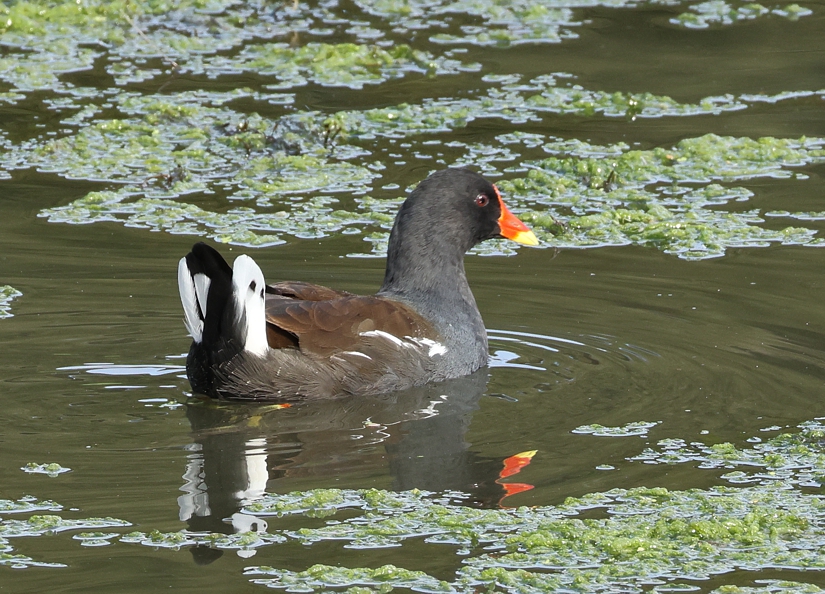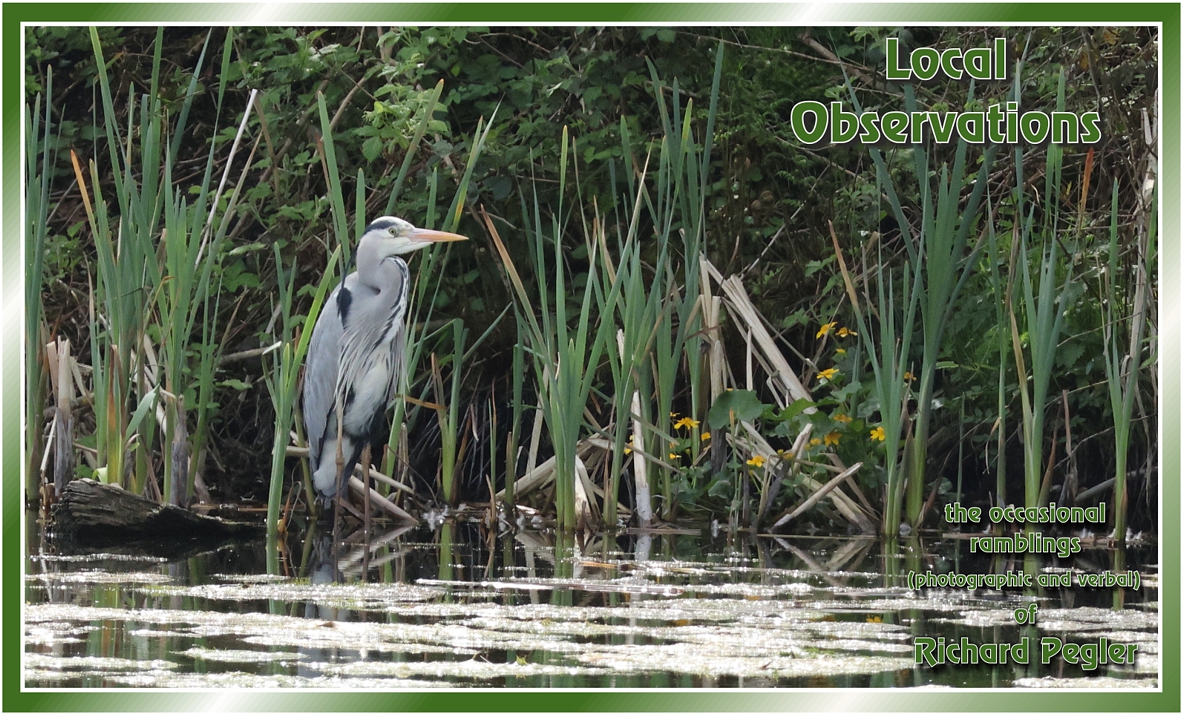Header image (while this post is current) - Common Buzzard - Thortit Lake on 6th September, 2023
With this post I am, at last, reporting sightings in the same month as they happened!
Sunday, 3rd September Garden : Donisthorpe Wood : Saltersford Valley Country Park
In the morning, I spent some time in the garden doing some general tidying up, during which I was keeping an eye open for wildlife on any items I pruned. This resulted in me finding a number of shieldbugs of three different species. I am rather fond of shieldbugs, so this was very pleasing, although I know little about them. All but one of the shieldbugs found were on the sunflower heads.
 |
| Hawthorn Shieldbug (Acanthosoma haemorrhoidale) (adult) - our garden |
 |
Hairy Shieldbug (Dolycoris baccarum) (adult) - our garden
|
 |
Common Green Shieldbug (Palomena prasina) (3rd instar nymphs) - our garden
|
On this day, I was booked on an afternoon walk organised by Groundwork Five Counties in conjunction with The National Forest. This was billed as a 'Bug Hunt'. I turned up to the news that the designated guide had called in sick with Covid. However, a well-experienced substitute had been found. What I was not prepared for was the nature of the walk, which largely consisted of swiping sweep-nets through tree branches and ground vegetation, and examining what was in the nets. This was not my thing really, as I much prefer to seek and photograph items in their natural habitat. There were, nevertheless, some interesting items found and a few photos taken.
Beside the entrance to Donisthorpe Woodland from the car park was a fine example of Robin's Pincushion. Robin's Pincushion (also known as the 'Bedeguar Gall') is a gall caused by the larvae of a tiny gall wasp, Dipoloepis rosae. It is quite common.
 |
Robin's Pincushion - Donishorpe Woodland
|
There were a few grasshoppers around.
 |
Lesser Marsh Grasshopper (Chorthippus albomarginatus) - Donisthorpe Woodland
|
One of the items swept from its resting place was the beautiful caterpillar of the Pale Tussock moth. Unfortunately, this creature was still suffering from the shock of being displaced and didn't straighten itself out from its defensive curled state.
 |
| Pale Tussock (Calliteara pudibunda) (larva) - Donisthorpe Woodland |
One of our eagle-eyed participants - a fellow dragonfly enthusiast - spotted scars on a willow that was overhanging an isiolated remnant of the Ashby Canal. These scars were left by the oviposition of the Willow Emerald Damselfly. This species is rapidly expanding its territory in UK and was first reported in our county in 2019. This damselfly bores into branches that are above water and lays its eggs. When they hatch, the newly-hatched nymphs drop into the water to start the aquatic stage of their life
 |
Oviposition scars of the Willow Emerald Damselfly (Chalcolestes viridis) by Donisthorpe Woodland
|
Although a Migrant Hawker dragonfly was seen beside the canal I didn't manage any photos. There were, however, Common Darter dragonflies seen in several locations.
 |
Common Darter (Sympetrum striolatum) (male) - Donisthorpe Woodland
|
There was an element of hilarity created when a Common Darter landed on the cap of the dragonfly enthusiast that had found the Willow Emerald scars.
 |
| Common Darter (Sympetrum striolatum) (female) - Donisthorpe Woodland |
Saltersford Valley Country Park is only about a mile (1.6km) from Donisthorpe Woodland, and is one of my favourite dragonfly spots. My new pal, Lance - the fellow that had found the damselfly scars, and owner of the dragonfly magnet cap - was not aware of this place, so I took him there after the walk.
Surprisingly, there were more Migrant Hawkers than there were Common Darters - and they were landing. Lance was delighted as he got his first Migrant Hawker photos of the year.
 |
Migrant Hawker (Aeshna mixta) (male) - Saltersford Valley CP
|
Wednesday, 6th September Thortit LakeA mid-afternoon visit to Thortit Lake - my nearest dragonfly hotspot - turned out a little different to what I was expecting.
I was not surprised to find Brimstone near my entrance point, off Willesley Woodside.
 |
| Brimstone (Gonepteryx rhamni) (male) - by Willesley Woodside |
|
Although I saw several Migrant Hawker and a couple of Brown Hawker dragonflies, I was seeing Ruddy Darters almost everywhere - it was quite remarkable as, until this time, I had seen very few of this species this year.
I have been a little uncertain about showing the first shot, below, as it is not a good photo, but there's something about it that I find pleasing.
 |
Ruddy Darter (Sympetrum sanguineum) (male) - Thortit Lake
|
This next one's for my good friend David.
 |
| Ruddy Darter (Sympetrum sanguineum) (male+femal in cop) - Thortit Lake |
At one point I noticed a juvenile Moorhen that was running with ease across the dense algae covering on an area of the lake. Look at the size of its feet!
 |
Moorhen (Gallinula chloropus) (juvenile) - Thortit Lake
|
. . . . .and another shot of a Ruddy Darter - this time, side-on.
 |
| Ruddy Darter (Sympetrum sanguineum) (male) - Thortit Lake |
On my way back to the car, I was alerted to the presence of Common Buzzards by their distinctive calls. There were four of them together, high up and distant. However, they broke away from each other and one came close enough for some photos.
 |
| Common Buzzard (Buteo buteo) - Thortit Lake |
Thursday, 7th September GardenIt was around this time that a male Sparrowhawk started to make a nuisance of itself. So far, we have not seen it catch anything, but we are alerted to its presence by the sound of warning calls from the birds and the occasional thump as a bird, in panic, strikes a window. We have lost a few birds in this way over the years, but on many an occasion I have gone out to a bird that has been stunned, and wandered around the garden with it in my warm hand for up to an hour before it revives and flies away.
 |
| Sparrowhawk (Accipiter nisus) (male) - our garden |
Wednesday, 13th September Thornton Reservoir and Brown's WoodIt had been a week since I had been out and prompted by a message from my new pal, Lance, who had been to Thornton Reservoir and seen "lots of Willow Emerald Damselflies and lots of Emerald Damselflies at Brown's Wood", I thought that I'd check it out as I'd not yet connected with Willow Emerald Damselflies this year. I was uncertain as to what my chances were as it had been a day of torrential rain the day before.
I arrived at Thornton Reservoir to find the car park all but full. Fortunately I was in our very small Smart, so was able to find a parking space.
From the car park, drawn by an unusual call, I found an alien! It was, I believe, a Chinese Goose, the origins of which were, of course, extremely dubious.
 |
| Chinese Goose (Anser cygnoides) - Thornton Reservoir |
As I approached the cafe area, a juvenile Moorhen scuttled down the slipway.
 |
| Moorhen (Gallinula chloropus) (juvenile) - Thornton Reservoir |
Outside the cafe, there is a Willow that ovehangs the water. Here I saw a Migrant Hawker dragonfly and an emerald damselfly that settled but I couldn't get focus on before it flew. I am 95% sure that it was a Willow Emerald Damselfly. I waited patiently for a long while, but it didn't return.
The shape of Thornton Reservoir reminds me of a human double tooth, with the dam forming the biting surface and the two inlet arms being the roots of the tooth. The path to Brown's Wood leads off from just past the first inlet. My target was the two ponds that are in Brown's Wood. I had not been there before, and I soon found myself a little lost. In the end, I had to resort to finding my position on Google Earth, and chcking my progress as I went.
In the end, I found the two ponds. Little of the pond edge was accessible at the first pond and I got very wet feet and legs in the long grass.
To cut a long story short, I got a grabbed shot of a warbler that I believe to be a Chiffchaff (dark legs on another even worse shot than this one).
 |
probable Chiffchaff (Phylloscopus collybita) - Brown's Wood
|
There were a few Ruddy Darters and Common Darters.
 |
Ruddy Darter (Sympetrum sanguineum) (male) - Brown's Wood
|
 |
Common Darter (Sympetrum striolatum) (male) - Brown's Wood
|
I also found a damselfly that had me puzzled for a while, until I realised that it was an immature female Common Blue Damselfly.
 |
Common Blue Damselfly (Enallagma cyathigerum) (immature female) - Brown's Wood
|
At the second pond, nothing was visible for a while and then a male Southern Hawker showed up. I tried for some flight shots but failed. It then flew off. I hung around for anther twenty minutes but it didn't show again.
As I had a commitment later that afternoon it was time to head back. I had originally intended to do a complete circuit of the reservoir, but I had not left myself enough time so I headed back the way that I had come.
I saw more on the way back than I did on the way out. There were adult Moorhens out on the water.
 |
| Moorhen (Gallinula chloropus) - Thornton Reservoir |
I saw several Common Blue Damselflies, and two of them were engaging in strange abdomen waving.
 |
| Common Blue Damselfly (Enallagma cyathigerum) (male) - Thornton Reservoir |
There were also young Little Grebes around, with an adult not too far away. The water disturbance in front of this chick is where the adult has just dived.
 |
Little Grebe (Tachybaptus ruficollis) (chick) - Thornton Reservoir
|
A juvenile Moorhen looked very confident out on the water.
 |
| Moorhen (Gallinula chloropus) (juvenile) - Thornton Reservoir |
After Mallard, Tufted Duck must be our most common duck, but they are rather handsome.
 |
Tufted Duck (Aythya fuligula) (male) - Thornton Reservoir
|
My last photos before I left were of a Red Admiral butterfly on ivy.
 |
| Red Admiral (Vanessa atalanta) - Thornton Reservoir |
By the end of the visit, I had not seen a single Emerald Damselfly and only seen one possible Willow Emerald Damselfly. However, it had been an interesting visit which included new territory for me, and was, therefore, a worthwhile one.
My next post, probably in about a week's time, will bring matters as good as up-to-date.
In the meantime, please take good care of yourselves and Nature. Thank you for dropping by - - - Richard







































































